 |
| The Independent Traveler's Newsletter PAGE THREE |
 |
| The Independent Traveler's Newsletter PAGE THREE |
THE BOOKSHELF: Moments Parfaits in Paris by Sylvaine Lang
Sylvaine grew up in Paris and spent many holidays at her great grandmother's country home in the Lot département. She was inspired by her father to go to the United States after he spent a few years in the southwest, but she and her American husband return several times a year to France which allows her to "keep one foot in each country". You may very well recognize her name as she is the owner of French Selections, a company she founded in California in 1989, and which publishes the very popular Joie de Vivre mail-order catalog where you can find authentic French specialties from delicious gourmet food to quality gifts. Her web site offers recipes, cooking tips and more to keep you connected to France. The vignettes in the book are delightful. I especially enjoyed The doctor will see you now telling of her friend's need for a prescription, the pharmacist insisting he see a doctor who would write the prescription, and then sending him to a doctor who happened to be a psychoanalyst. Or Leche-Vitrine, the baking disaster she had when she offered to make dessert for a family gathering, and it didn't turn out well at all ~ which led to her fascination with pastry shops. Here she provides the reader with a description of Ladurée in the 8th arrondissement accompanied by a mouth-watering photo of pastel macarons. Or Murphy, her chance meeting at Gare Austerlitz with Candace Bergen and her daughter when she was visiting Paris with her husband in the early 90s ~ and she tells us about the station's history and its current state of renovation. Most admirable, however, is Roundabout, her recounting the time she got behind the wheel of her mother's Citroën to enter and conquer the roundabout at the Arc de Triomphe. She steeled herself, entered the fast-moving traffic as cars were exiting or entering the twelve radiating boulevards and successfully exited without incident. There is so much to enjoy through these personal and very well written recollections, from many humorous moments to those more serious and personal. In all cases this is a pleasant tour of Paris through the eyes and camera lens of someone who truly loves the city ~ whether returning to a familiar place or searching a neighborhood to find if it changed or stayed the same. Sylvaine kindly provides the address of each location in the book along with a map of the city's arrondissements so that you can follow in her footsteps the next time you visit Paris. Moments Parfaits in Paris can be purchased on the French Selections web site, https://www.frenchselections.com where you can also browse the Joie de Vivre catalog, visit Sylvaine's blog, or check out her favorite French recipes. A Visit to Occitanie & the Pyrénées . . . Pyrénées-Orientales continued from page one  It was 1995, and we approached the Cerdagne from the Ariège département on the RN20, aware that we would enter a rather long tunnel, the Puymorens road tunnel, but never did we suspect that it was almost 3 miles in length! However, once we saw how convenient a shortcut the tunnel was, we were quite happy and would gladly take it again. The weather in the Ariège that day was overcast, but as we emerged on the Pyrénées-Orientales side, the sun was bright and the skies were clear. Our destination was the tiny hamlet of Llo in the Cerdagne, where we were reminded by our host that the Pyrénées-Orientales have 300+ days of sunshine a year, and this day had apparently been one of them. The Puymorens Tunnel entering in the Ariège, the tunnel going south after entering, the Pyrénées-Orientales side and toll booth There were
several reasons for building this tunnel including better access from
Toulouse to Barcelona as well as creating a central crossing of the
Pyrénées in all seasons. It was French President
François Mitterand who decided to build this tunnel ~
construction began in 1988 and was completed in 1994. He was
joined by the president of Spain and an official from Catalunya at its
inauguration in
December of 1994. The tunnel was closed for 7 months in both 2013
and again in 2015 to improve tunnel safety: fire protection
shelters
were increased from 5 to 11 and were connected to a ventilation duct
above for emergency exits. The tunnel is one bi-directional tube
with two turning areas and is quite an engineering feat.
The Cerdagne is a green plateau between 1200 and 1500 meters above sea level, surrounded by beautiful mountains and "bathed by the southern sun". Llívia ~ and now you're in Spain!
Llo is the most unusual village we've ever seen in France. A cluster of homes and a church, perhaps some shops for necessities, lining the hillsides ~ population around 171 at last count. In 1995 the population was 22% lower, so it seems that people are discovering this unique getaway. Our first hidden gem: Although information available indicates that there are many hotels in the hamlet, there is really only one, L'Atalaya, with all the others nearby in Saillagouse. Our stay at L'Atalaya was delightful. Our friendly and charming host provided information about the area, our room was perfect, and we set off a few days later for Andorra, happy to have been able to spend some time in this special place. It is our understanding that Monsieur, a former pilot with Air France, has since passed away, but his wife Ghilaine has continued to welcome guests to her home in Llo, the oldest and most typical village in the Cerdagne, as they have for all the years since their arrival from Paris. There are five bedrooms with en suite modern bathrooms and two spacious gîtes for self-catering holidays. Visit http://www.atalaya66.com. 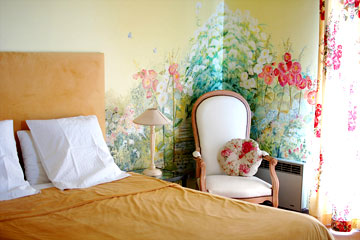 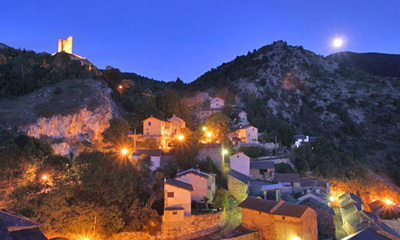 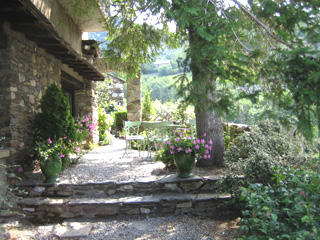 A
lovely guest room at
L'Atalaya, the hamlet of Llo in the
evening, and
L'Atalaya's cozy garden with a place to dine
en plein air
Taking advantage of nearly 2500 hours of sunshine a year in this region, the French have a head start on many other countries when it comes to alternative energy sources. The Solar Furnace at Odiello was very useful during the 1973 world oil crisis, generated power to make electricity and is still in operation. The nearby Themis generating plant stopped operation in 1986 due to a lack of political and financial support, but in 2004 a rehabilitation project began, and it has become a research center for CSP (Concentrated Solar Power). A group of ten partners is working on the development and integration of a new technology to be tested at France's Themis facility. 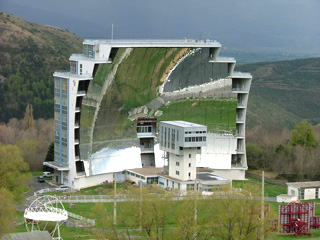 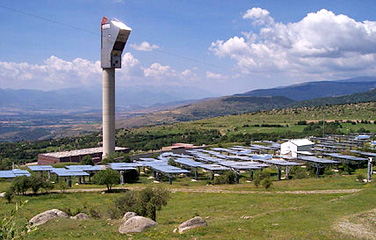 The Odiello Solar Furnace,
the world's largest, built between 1962 & 1968 and the Themis solar
generating plant, 3 kms north of Odiello
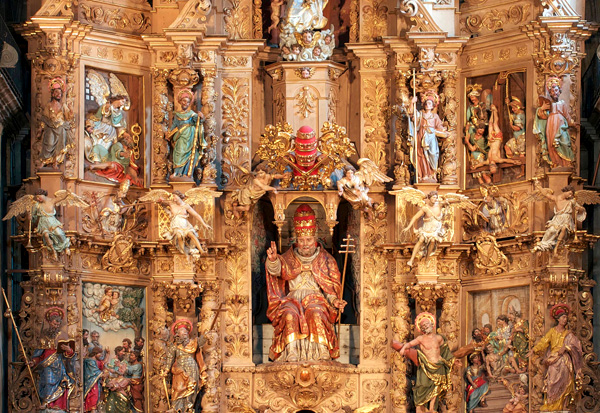 The Pyrénées-Orientales is divided into three administrative arrondissements, reduced in January 2017 from the five shown on the map on page one: Céret, Prades and Perpignan. Until now we have been in the Prades arrondissement which contains the most communes of the three (100) and is the largest in area but is the least densely populated. The geography is that of rolling hills, valleys and meadowlands with the Pyrénées mountains as a backdrop. Two rivers flow through the Pyrénées-Orientales, the Tet and the Tech. Its principal city is Prades, perhaps best known to the outside world as the adopted home of Pablo Casals during the Spanish Civil War. There is a museum dedicated to him in a new room in the Library Pompeu Fabra where valuable documents such as his Master recordings from 1925 to 1960, authentic letters, an original orchestral score, audiotapes of interviews, films, paintings and sculptures are preserved. L'Eglise St-Pierre de Prades dates from the 17th century having been built on the remains of an early Romanesque church, and it contains treasures from the nearly 1200-year old Benedictine Abbaye de St-Michel de Cuxa collected during the French Revolution. There is the astonishing baroque altarpiece of St-Pierre [photo at right], a masterpiece by Catalan sculptor Josep Sunyer, known as the largest in France and classified a Monument Historique. The Romans built the Abbaye de St-Michel de Cuxa (begun in 840 AD) and Abbaye de St-Martin du Canigou (dating from 1009), the latter built on a rocky spur at the edge of a precipice. The Tourism Office refers to them, as well as the Priory of Marcevol and St Mary's Church, as jewels left behind by the Romans from their time here in the eleventh and twelfth centuries. We are constantly reminded of the construction skills and artistry of the Romans as we travel through France ~ how their monuments including churches, aqueducts, temples, amphitheaters, arenas, baths, forums, arches and more survived for over 2000 years. Although most of the Roman monuments are in the south of France, there are some in the north and Paris has its fair share. We especially appreciate the care and attention paid to all of these by the French, whether in the care of local governments, private parties or the state. They are protected, cleaned, and honored as part of the country's heritage and history. 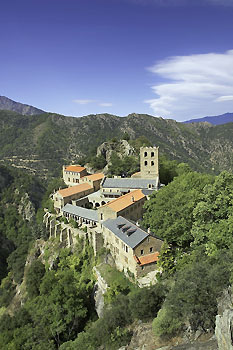 The Abbaye de
St-Martin de Canigou and the Abbaye de St-Michel de Cuxa, Roman
architectural treasures of Prades
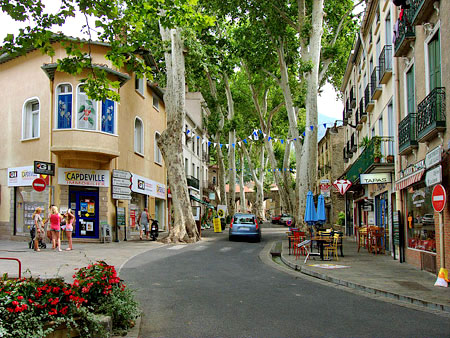 The
Céret arrondissement
has
as its capital
the town by the same name lying on the banks of the River Tech.
This is a rugged area bordering Spain that extends The
Céret arrondissement
has
as its capital
the town by the same name lying on the banks of the River Tech.
This is a rugged area bordering Spain that extends 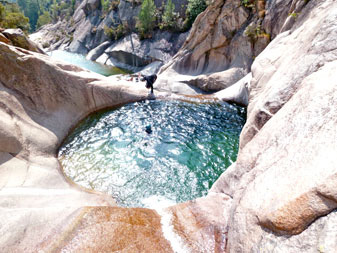 from
the Cerdagne eastward to the
Mediterranean where you will find the seaside town of Collioure ~
without a doubt the best known to tourists in this part of France. from
the Cerdagne eastward to the
Mediterranean where you will find the seaside town of Collioure ~
without a doubt the best known to tourists in this part of France.Céret has become a destination for northern Europeans in the last twenty-five or more years, and the expats calling it home come from Britain, Germany, The Netherlands and Scandinavia. It is a friendly town, very welcoming to new residents whether they be permanent or buying holiday homes. It boasts a thriving artisan population, a fine Saturday market, an authentic old town, many restaurants and bistros and a well-to-do French and Catalan population. In May, you can enjoy the Fête de la Cerise ~ the popular local cherry festival. Picasso lived here between 1911 and 1913, and Matisse, Miro, Chagall and other artists also found it appealing. The Musée d'Art Moderne houses their work and that of some of their contemporaries as well as 21st century modern art. The town has galleries and studios for those interested in seeing or purchasing the work of local artists and craftspeople. The area around Céret has much to offer those who prefer the outdoors for hiking, horseback riding, exploring on mountain bikes, or, as seen in this photo: canyoning! There is the massive Fort de Bellegarde designed by Louis XIV's foremost military engineer Vauban, open to visitors between June and September and listed as a Monument Historique by the French Ministry of Culture since 1967. Another structure worthwhile seeing is Le Pont du Diable de Céret over the River Tech. It was the world's largest arched bridge until 1356. It is one of many 'devil's' bridges in France, each with its own local legend, and this bridge was the subject of a painting by Paul Cézanne. 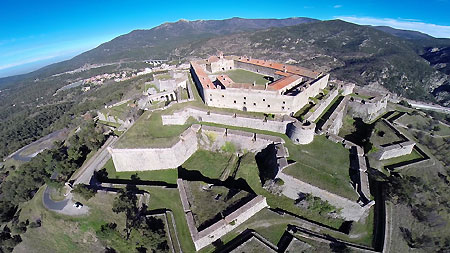 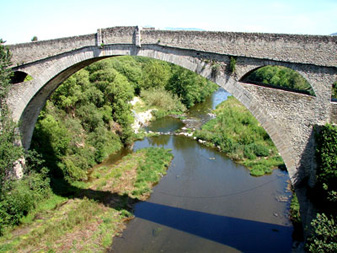
Fort de Bellegarde by
Vauban
Le Pont du Diable de
Céret over the River Tech
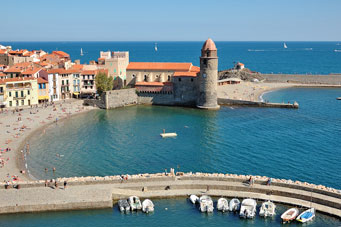 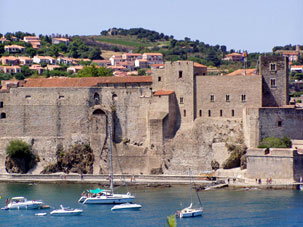 Off to the Mediterranean and to the town of Collioure. The 1659 Treaty of the Pyrénées made this strategic town part of France, and once again French military engineer Vauban improved the fortifications of Château Royal de Collioure and the stronghold of Fort Sainte-Elme. For about a year beginning in 1793 the town was occupied by Spanish troops, but they were driven out, and it has remained in French hands ever since. Fauvist painters made the town a gathering place in the early 20th century. Among those were Picasso. Braque and Matisse ~ all attracted to its castle [photo at right], bay and Medieval buildings and lanes. Collioure is also the name of AOC wines produced from vineyards on the terraced hills behind the town ~ reds, rosés and some white wines ~ and these vineyards are adjacent to Banyuls vineyards producing sweet dessert and apéritif wines. The wines of Collioure are dry from this the most southerly of French wine regions from vineyards perched on cliffs high above the western Mediterranean far below. The red wine is characterized by its intense bouquet and notes of spice. The rosé wine is from the same grapes but with added Grenache Gris. Changes in the AOC regulations twelve years ago now permit the production of white wines in Collioure which are unique and rich. We found that there are nearly 70 vintners in this seemingly small wine producing region, so there are many for one to visit. If you are seeking a great beach, just north of Collioure is Argelès-sur-Mer with seven kilometers of beautiful, wide, sandy beach on La Côte Vermeille, the coastline that stretches from Argelès Plage to the Spanish border. The beach received the coveted European Blue Flag award for the quality of the water and the cleanliness of the beach, and the coastline is very dramatic with the Pyrénées mountain range as a backdrop. In the late 1930s the population grew with the arrival of refugees fleeing Franco's Spain, who were disarmed and confined to a concentration camp at Argelès. Up to 100,000 men, women and children were in this camp and other smaller camps at the end of the Spanish Civil War where they had been fighting against the Fascist Franco government. They lived under horrific conditions in the camps where many died of disease and despair. The French were party to a European non-intervention treaty which prevented the refugees from receiving aid, and the Vichy government had no qualms about confining the refugees who bravely fought Fascism and sought unattainable freedom in France. A commemorative plaque is on the beach in memory of their sacrifice. Two books on this subject are by Quaker Rosemary Bailey (Love and War in the Pyrénées - Phoenix ISBN 9780753825914) and by Pablo Casals (Joys and Sorrows - Reflections by Pablo Casals, edited by Albert E Khan - Macdonald ISBN 356030482) and available on Amazon.com. Today, Argelès-sur-Mer is a popular vacation destination hosting about 300,000 visitors each year. There are barely any traces of this regrettable episode of the town's history other than the commemorative plaque. 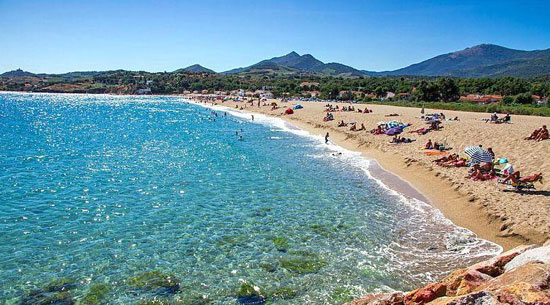 The sandy beach at
Argelès Plage with the backdrop of the Pyrénées
Mountains
continued
on page 4
|